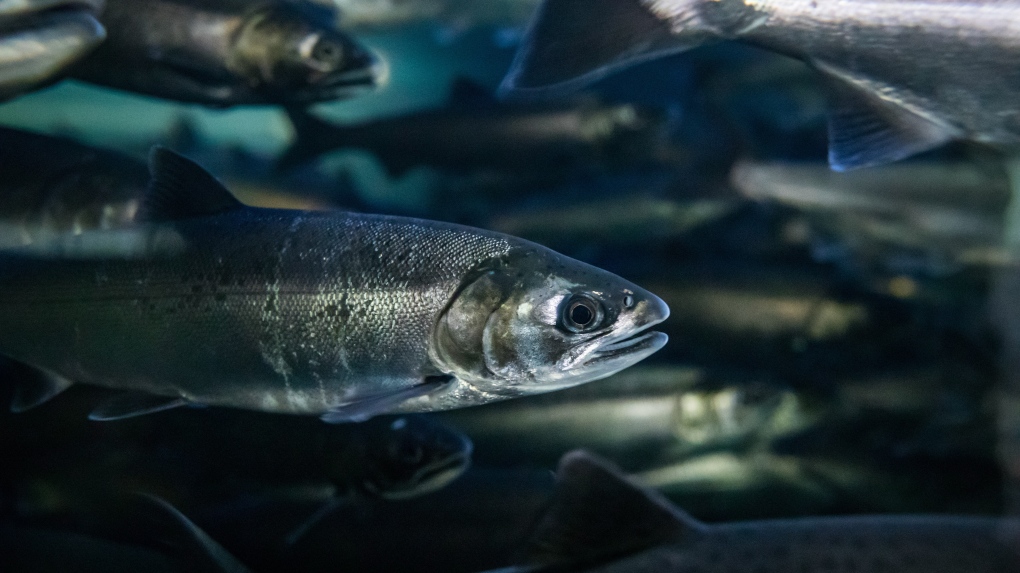B.C. environmental groups request review of tire chemical linked to salmon deaths
 Coho salmon swim at the Fisheries and Oceans Canada Capilano River Hatchery, in North Vancouver, on Friday July 5, 2019. THE CANADIAN PRESS/Darryl Dyck
Coho salmon swim at the Fisheries and Oceans Canada Capilano River Hatchery, in North Vancouver, on Friday July 5, 2019. THE CANADIAN PRESS/Darryl Dyck
Conservation groups have written to the federal environment minister requesting a review of a chemical used in tires that they say has been linked to the “mass deaths” of coho salmon.
Peter Ross, senior scientist at Raincoast Conservation Foundation, says the mystery of coho dying in urban waterways had persisted for years, until a 2020 study uncovered the role of a particular chemical used in tire rubber.
Ross says the study published in Science, a top academic journal, found a chemical known as 6PPD produces a breakdown product that's acutely toxic for coho.
He says the study showed toxic concentrations of 6PPD-quinone after rain events in Seattle-region watersheds, suggesting it was flowing off roads and into streams.
Raincoast, the Watershed Watch Salmon Society and Pacific Salmon Foundation, all based in British Columbia, are asking Ottawa for an assessment of the chemical under the Canadian Environmental Protection Act.
A letter to Environment Minister Steven Guilbeault this week says the federal government evaluated 6PPD in 2018, finding it posed a “moderate hazard with high exposure,” but the screening did not account for the breakdown of the product.
Ross says it's the breakdown substance, 6PPD-quinone, which a growing body of research is linking to coho deaths as the fish return from the ocean to spawn.
The breakthrough came after researchers had been “sleuthing” for 20 years, looking at all the potential culprits, from hydrocarbons to parasites to road salts, he says.
Eventually, they figured out that a “previously undocumented chemical” was responsible, says Ross, who serves as director of healthy waters at Raincoast.
“It's really a remarkable scientific story,” he adds.
“It's very, very difficult to establish cause and effect relationships between any single pollutant and the health of salmon, because we are exposing salmon to thousands upon thousands of different chemicals and pollutants in their lifetime.”
Several groups in B.C. are working on monitoring for 6PPD-quinone in waterways throughout the Lower Mainland and southern Vancouver Island, Ross says, adding scientists with Raincoast are among those who have detected it in the province.
This report by The Canadian Press was first published Feb. 7, 2024.
CTVNews.ca Top Stories

Walking pneumonia is surging in Canada. Is it peaking now?
CTVNews.ca spoke with various medical experts to find out the latest situation with the typically mild walking pneumonia in their area and whether parents should be worried.
NEW Thinking about taking an 'adult gap year'? Here's what experts say you should know
Canadian employees are developing an appetite for an 'adult gap year': a meaningful break later in life to refocus, refresh and indulge in something outside their daily routine, according to experts.
Prime Minister Trudeau attends Taylor Swift's Eras Tour in Toronto with family
Prime Minister Justin Trudeau is a Swiftie. His office confirmed to CTV News Toronto that he and members of his family are attending the penultimate show of Taylor Swift's 'The Eras Tour' in Toronto on Friday evening.
Afraid of losing the U.S.-Canada trade pact, Mexico alters its laws and removes Chinese parts
Mexico has been taking a bashing lately for allegedly serving as a conduit for Chinese parts and products into North America, and officials here are afraid a re-elected Donald Trump or politically struggling Prime Minister Justin Trudeau could try to leave their country out of the U.S.-Mexico-Canada free trade agreement.
ICC warrants are binding, EU cannot pick and choose, EU's Borrell says
European Union governments cannot pick and choose whether to execute arrest warrants issued by the International Criminal Court against two Israeli leaders and a Hamas commander, the EU's foreign policy chief said on Saturday.
UN talks in disarray as a rough draft deal for climate cash is rejected by developing nations
As nerves frayed and the clock ticked, negotiators from rich and poor nations were huddled in one room Saturday during overtime United Nations climate talks to try to hash out an elusive deal on money for developing countries to curb and adapt to climate change.
'Her shoe got sucked into the escalator': Toronto family warns of potential risk of wearing Crocs
A Toronto family is speaking out after their 10-year-old daughter's Crocs got stuck in an escalator, ripping the entire toe area of the clog off.
The Thriftmas Special: The benefits of second-hand holiday shopping
The holidays may be a time for family, joy and togetherness, but they can also be hard on the wallet.
Whole Foods carrots pulled in expanded recall for E. coli: CFIA
The Canadian Food Inspection Agency has announced an expanded recall on carrots over risks of E. coli O121 contamination, according to a notice issued Friday.

































